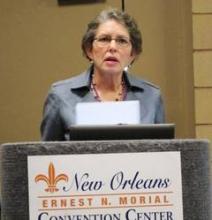NEW ORLEANS – The Multidimensional Objective Pain Assessment Tool can be used to assess and guide relief of acute pain in noncommunicative hospice patients in an inpatient setting, a study has shown.
"The MOPAT was reliable, fast, and clinically useful," Deborah McGuire, Ph.D., said at the annual assembly of the American Academy of Hospice and Palliative Medicine.
Assessing pain in patients who can not self-report their pain is a continuing clinical challenge, she observed. There are few validated assessment tools, and the limited research that is available is typically in partially cognitively impaired patients, limiting the ability to extrapolate the findings to patients who are fully cognitively impaired.
To address this gap, investigators at the University of Maryland School of Nursing in Baltimore validated the MOPAT, which consists of a four-item behavioral dimension ranked on a 3-point scale with 0 being none and 3 severe, and a three-item physiologic dimension rated as "no change from usual" or "change from usual." Both dimensions are summed for a total score of pain severity.
As part of the hospital study, staff and study nurses also used the MOPAT before and after pharmacologic and nonpharmacologic pain interventions in 100 patients admitted to a community-based hospice in a noncommunicative state and receiving palliative care for a diagnosis or condition known to cause acute pain.
Their average age was 72.6 years (range, 35-99 years); 61% were women; 92% were white; and 53% were in the active/terminal phase of dying. Other reasons for noncommunication included expressive/receptive aphasia (15%), metabolic encephalopathy (7%), stroke (6%), malignancy (5%), and delirium (5%). Pain was typically due to functional activities such as bathing and turning patients (57.3%), followed by inadequate analgesia in 31% and other reasons in 12%.
Agreement between staff and study nurses on pain ratings before and after the pain interventions was generally good on both the behavioral dimension (61.2% vs. 73.3%) and physiologic dimension (79.6% vs. 78%), said Dr. McGuire, professor of nursing at the university.
Results for internal consistency were acceptable for the behavioral dimension (alpha coefficient, 0.77 for study nurses and 0.81 for staff nurses) and for the overall scores (0.77), but not for the physiologic dimension (0.44 for study nurses; 0.63 for staff nurses). The inability to scale the severity of physiologic indicators likely contributed to the low alpha coefficients for this dimension, she said, adding in an interview that the dimension is currently being revised for the investigators’ next study.
Still, pain scores as rated by staff nurses decreased significantly after the pain interventions on the behavioral (mean, 6.3 vs. 1.7) and physiologic dimensions (mean, 1.49 vs. 0.89), indicating that "the MOPAT was sensitive to changes in pain and therefore a good measure of pain severity," Dr. McGuire said at the meeting, also sponsored by the Hospice and Palliative Nurses Association.
When surveyed on how often they encountered patients unable to communicate, 64.5% of 62 nurses said frequently; 32%, occasionally; and 3.2%, constantly.
Using a five-point scale, nurses also reported that the MOPAT was easy to use (mean score, 3.86); was easy to understand (3.90); assisted in communicating to others about the patient’s pain (3.67); and was helpful in determining whether the patient might need a pain relief intervention (3.64).
Dr. McGuire noted that the Hospice of Lancaster County (Pa.) has incorporated the MOPAT into its pain standard of care in the inpatient units and the home setting, and that it will be tested in combination with analgesic order sets in 22 different hospital inpatient units to examine pain-related outcomes such as severity and treatment choice.
"What we are aiming at in our longer-term program of research is to be able to find a simple tool that can be used to assess pain in people who can’t self-report across various settings in which palliative care is given – not just acute care or hospice," she said.
The National Institute of Nursing Research sponsored the study. Dr. McGuire and her coauthors reported no relevant financial disclosures.



